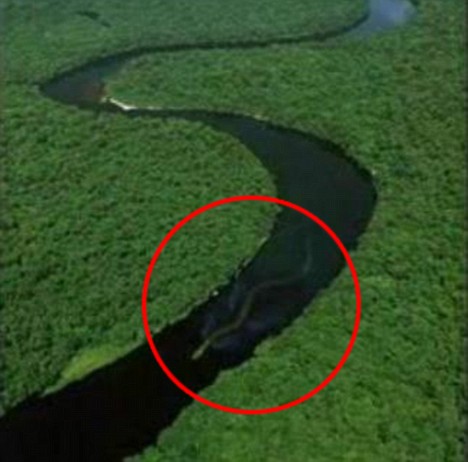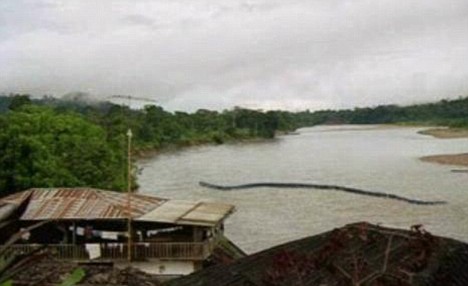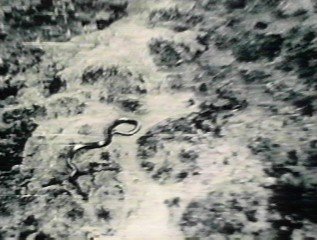Borneo Giant Snake Photographed: Hoax
Posted by: Loren Coleman on February 19th, 2009


Photographs have allegedly been taken of a giant serpentine animal, apparently a snake, near Ulu Rajang on the Baleh River in Borneo, we are suppose to believe. The images, taken by Sibu, a member of a disaster team monitoring flood regions by helicopter, has sparked Internet chatter and media debate.
Reportedly the photographs of the huge snake were taken at 5.30 pm, on January 31, 2009, at one of the Sungai Baleh tributaries from the helicopter. But indeed, they are old photos, which have been floating around the internet since at least 2007, er, make that 2002. See YouTube url noted, below.
Even the rather credible The New Straits Times newspaper in Kuala Lumpur and the Daily Mail of the UK have asked readers for comments about the photos. No reason not to show it here at Cryptomundo and put this one to rest!
Discussions have been about whether the photos are genuine or merely the work of computer photoshopping-type software. Some have said it is merely a log.
As one writer at The New Straits Times asked: “A log can’t be that winding, can it?”
Others have suggested it’s a speedboat, but this has been dismissed because of the twisting wake.
According to legend, as mentioned at sites such as The New Straits Times and The Broken Shield, the Nabau is the local name for this snake said to be more than 100 ft in length and with a dragon’s head and seven nostrils.
As I have mentioned here recently, with the Columbian discovery of the giant 45 ft long fossil snake, Titanoboa, there have been new accounts of a 39 ft snake being sighted in the jungles of Columbia. Should we be surprised an old hox has resurfaced?
Now this news from the rainforests of Borneo slithers into our awareness.
Sources: Daily Mail; The Broken Shield; The New Straits Times (article appears to have no current links now).
Thanks to Jason Pritchett for the initial heads up.
++++

So as not to create any confusion, directly above is the famed photograph taken by a Belgian helicopter pilot, Remy Van Lierde, allegedly during a patrol over a river in the Republic of Congo in 1959. The snake he witnessed has been estimated to be about 40-50 feet long.
About Loren Coleman
Loren Coleman is one of the world’s leading cryptozoologists, some say “the” leading living cryptozoologist. Certainly, he is acknowledged as the current living American researcher and writer who has most popularized cryptozoology in the late 20th and early 21st centuries.
Starting his fieldwork and investigations in 1960, after traveling and trekking extensively in pursuit of cryptozoological mysteries, Coleman began writing to share his experiences in 1969. An honorary member of Ivan T. Sanderson’s Society for the Investigation of the Unexplained in the 1970s, Coleman has been bestowed with similar honorary memberships of the North Idaho College Cryptozoology Club in 1983, and in subsequent years, that of the British Columbia Scientific Cryptozoology Club, CryptoSafari International, and other international organizations. He was also a Life Member and Benefactor of the International Society of Cryptozoology (now-defunct).
Loren Coleman’s daily blog, as a member of the Cryptomundo Team, served as an ongoing avenue of communication for the ever-growing body of cryptozoo news from 2005 through 2013. He returned as an infrequent contributor beginning Halloween week of 2015.
Coleman is the founder in 2003, and current director of the International Cryptozoology Museum in Portland, Maine.










Not sure if the top two photos are supposed to be of the same specimen, but judging (oh so roughly) by the scale of the trees, these could not be the same snake if it is real.
The top photo, really smells of Photoshop, the second one looks more realistic to me, though not quite so convincingly a “snake” as the first one.
Thats a hundred foot plus.
it could be the the floats to a fishing net. i think they’re usally yellow or some color thats easier to see.
just a net floating down river?
on the overhead shot the snake looks alot thicker than the shot thats alot closer.
That first photo is the fakest thing I have ever seen. That snake’s gotta be half a mile long if it’s real. Color me skeptical.
These look crazy fake to me. The top photo – if you use the trees as a reference point – would have a head as big as the canopy top of some of the nearby trees. If a “known point” could be assigned to this we could figure the length by comparing to the measured width of the river at that bend.
The second photo – if it shows a real animal – doesn’t look like a snake in the water. It’s very straight. Most snakes use a wavy motion (like the one in the top photo) to get around in the water.
I love a good giant-snake story – but these aren’t very convincing. And, as ever, I’d really like a corpse.
IMO those picture are definately fake.
And the story is fake as well. The photos could not have been taken on Jan. 31, 2009 because there is a youtube video that was posted on July 28, 2007 that contains those exact photos.
http://www.youtube.com/watch?v=4oeE23DjrFc
I’d be willing to venture that the top one is a fake. One reason is what others here have already stated, using the trees as a reference point, the size of the thing is just ridiculous. It goes far beyond 45 or 50 feet, and I’d need more supporting evidence to swallow the idea of a snake that enormous. The wake that thing is producing would be swamping the shoreline.
Second, the color of the head is a bit lighter, and gives the impression that a good portion is being held up over the surface of the water while the rest of the body remains submerged. There is a very clear line where the coloring changes at the first wake it is producing and this make it seem as if it is just swimming along with its head aloft. This is not how snakes swim. For instance, if you watch an anaconda swimming, it does not hold up its whole head and neck dramatically over the surface of the water, but rather would have just a very small portion of the top of its head and nasal cavities exposed. They are not really built for swimming in the manner that seems to be depicted here.
The bottom photo is more what I would expect a swimming snake to look like, but it is unclear to me whether that is actually what we are seeing. This second photo is more intriguing, but there is no way it could be the same animal as the top photo, and the mix up of the dates that has been pointed out already casts some doubt on the credibility of the whole story for me.
well they all look real to me
The First one looks as if it’s the Megaconda!!!!!
my grandpa says the 2 pictures are Anacondas.. i told him NO, cause i know Anaconda’s are not that big, other wise, an Anaconda is a Megaconda …
it could be a boa.. i was reading a sighting about a 130ft boa in South America.!!!!
the first pic looks way to huge to be the 2nd pic…..
if the frist pic is real, and if it’s bigger then the megaconda.. then call it, Giganticondadon XD
I like snakes.!!! but i like giant snakes. 🙂
why? i don’t know!
but this snakes seems real!!!!!
no matter what proof you have, people are always going to reject it as fake!! cause they seem to have an open mind and not having an open mind can cause some people to not believe a real photo of a real cryptid found!!!!
besides if it’s fake, it may be reveield soon.
if it’s true, it will be found again
The verdict seems rather clearly to be an old photoshopping hoax (older than 2007), combined with the recent big fossil snake media mania of February 4th, equals faked giant snake photo news stories out of Borneo, via Malaysia and London.
1 + 1 = 0
Those pictures were not taken at the same location. The house/building isn’t in the first pic.
And it just looks fake.
The thing that made me suspicious about the fist photo first was how clear you could see almost all the body of the snake… in a river with water that looks pitch black from the height where the photo was taken! So I seriously doubt murky water could show you that humongous animal with such clarity.
The other arguments mentioned by my esteemed colleagues also seal the deal 😉
Just the fact that they would have taken multiple photos, flown closer, and taken more photos, points to a fake. It’s swimming down a river! They’re in a helicopter! Of course none of that actually happened.
ive been mooching round this site for some time now and decided to finally comment, think about this logically.
if you look at the first picture and in some cases the second we can see that the “serpent” has a head that sticks out of the water and any herpetologist or snake fanatic knows that this is instinctual to the snake.
people say that the photos are not proportional anyone ever thought that they are different photos???
anyway theses are just my ideas 🙂
Snake oil.
Doug
Fake snake.
Real? Pfft. Clearly that is nothing more than a fox with mange.
On a more serious note, I have always been intrigued by the famous Congo photo taken by the Belgian pilot shown at the bottom. It’s from well before the days of digital shenanigans, and while a simple fake with a model is possible, it’s a very well done one if that is the case.
Photoshoptacular…
Hi Loren,
I was about to berate you for posting these pics (obvious fakes), but then I read your notes 🙂
Its clear that a lot of people don’t bother to read what you’ve written. Something i’ll be sure to do before i submit any comments in future
The first photo looks like some drunken 5 year olds attempt at photoshop..
The 2nd photo is…interesting, but doesn’t seem to show a large snake.
The bottom photo interests me the most..It seems the most plausible and realistic looking
The bottom picture looks to me like the near edge of a long platform or deck that has been swamped by floodwaters.
It’s probably just a chicken. A Rhode Island Red hen that has lost its tail feathers to a predator can look a lot like a giant water snake. 🙂
You’re exactly right Loren, 1+1=0
Something definitely does not look kosher in any of those photos. It appears that there are 2 wakes in the first photo and they’re either identical (photo shop evidence?) or awfully similar. I wouldn’t think that a snake would throw off 2 wakes nor that they would be as symetrical neither. Wouldn’t a side to side motion make the wake lees uniform? The second photo just seems too clear for a side view.
Does anyone know about the Dadanawa area of Guyana? My Dad has some old (B & W old) episodes of Wild Kingdom on DVD, back when Marlin Perkins would actually leave the studio. One episode is ‘Giants of Dadanawa’.
I believe on the box or in the description of the episode there’s some info talking about the giant otters, giant anteaters, and giant anacondas of the area. He either states verbally or it’s also in the episode info of snakes reaching 39 feet in length. Can’t find anything that specific doing a quick Google search.
Anyone familiar with that area or info on that episode? Perkins stating that or allowing it to be associated with something he appears in would give it some credibility.
Also been lurking. Meant to post this a month or so ago when giant snakes where a topic on here. Seems to be a recurring subject.
Red Pill Junkie:
well your right, the water is not clear enough. but what i can come to mind is that
the snake is dark in color and it’s above the surface.. so the the snake would be hardly invisible. and
if i’m right.. the the body must not be skinning abut large enough to swallow a croc, unless it’s floating on the water but i find that unlikley
@ DJ Plasmic Nebula,
Let me see if I get you right: you think the snake is above the surface. Our friend mystery_man has noted that he sees the head and the first segment of the neck to be above the surface of the water and thus showing a clearer color—in fact, I think that this serpent’s color is no dark at all, it is a shocking bright green, which would be hardly ideal to camouflage such a large animal since its prey would literally see it coming a mile away, but I digress— he posits that this locomotion is highly unlike the way big serpents move through water; I agree, although would concede that we are not entirely sure if a significantly large snake would display a different locomotion than common pythons or anacondas (maybe it would need a different way to move due to its mass).
But getting to the point that we clearly see almost the entirety of the length of the reptile in clear contrast with the color of the water, which would make us think the animal is very close to the surface of the water, or practically floating. Again IMHO that would be hardly unlikely for a voluminous animal, unless it has a negative buoyancy —i.e. it is hollow like a boat or filled with gas— I’m speculating here and could be totally wrong, but I think a big serpent like the extinct Titanoboa the press has been talking about lately would sink in the water even more than crocodiles (even when a crocodile is idly floating on the water, only a very small percentage of its body is shown above the surface, that’s why these lovely critters developed eyes that stick out of the water even if the rest of the head is under it).
So to me, a giant serpent would have to be dark to camouflage itself easily, and would probably display such a low level of buoyancy that only a small fraction of it would be visible above the surface.
But maybe I’m wrong, maybe the great length of the animal would help it distribute its mass so it could swim with greater ease than say, a salty croc or a whale.
Concerning the 2nd photo, to me that’s a log.
It is actually a photoshop of a speedboat trailing a wake boarder…you can actually see the two sprays being kicked up from each. The trail of green is the disturbed water trail being left behind, if anyone has ever waterskied or wakeboarded, you know that the boat winds back and forth to allow for the trailing skier to jump across. The added on head is really bad editing, but funny nonetheless.
Red Pill Junkie: i must say, i agree with you to the extent that i can still find my own theory.
i do agree with the first pic.. but i don’t agree with you on the second pic..
the second pic is to large to be a log, unless it can from a giant tree somewhere in africa. which makes me believe that dinosaurs are still in africa hiding among the large trees.. but i must think that “if it’s a log” where did it come from?????!!! the picture doesn’t give enough evidence that the log just floated on by, the picture of the lake isn’t showing the whole lake from the right. so if the lake continues from the right that’s big enough for a large log to float on to the left as it shows on the picture than i can believe it would be a log”. but if the log suddenly resurfaces on the lake without no one knowing how the log got there , i have to say it’s a snake.
a Snake to me is a better candidate to just come out of the water.
then again, it’s in the water so it can have legs and fins.. you can’t tell from that picture cause it’s floating.
now the 3rd picture i know it’s a snake
If the first pic is a speed boat that is a giant speed boat.
The 1st pic is fake, taken at the hieght that the photo seems to be taken that snake is more than a 1/2 mile long. The 2nd one well that could be anything but I doubt a snake. The 3rd pic looks like a small snake in a small stream
Snakes are of big intersest to me and have over the last few years become more than a hobby, particularly large snakes like pythons. I spend a lot of time in my area catching large pythons and releasing them in safer areas, over the last 4 years I have caught over 30 ‘large” African python from various farms, and plenty small pythons. The calls for assistance usually start, “I have this 10m (25ft+) python in my garden” This is always taken with a pinch of salt as when I arrive to capture the specimen, they generally are not over 3m long and the average being 2.5m. The longest and biggest I have captured is 4.2m and this was reported by an experience hunter and game farmer as being not less than 7m, when it was caught he commented “must have shrunk”. Believe me a 4.2m python is massive. Many biologist, herpetologist etc agree that an expectional specimen is 5m long, 6-7m Extemely rare. The largest specimen I have seen is just over 5m and becuse we did not catch it I wont verify the length although all reference points on the pics taken indicate it to be over 5m.
Large snakes like this just cant be proven to exist, I know the comments, inaccesible areas etc they must be there, just take into consideration what they must feed on. Most areas where these pics come from do not support prey big enough to for it to eat, so it would constantly be feeding, 2ndly if it did take big prey it would not be very mobile and thus easy to find. My 5m+ python that I photographed, had taken a fully grown Implala ewe, and it was not very mobile after that, making it easy to find again.
With my experience and a few good friends experiences, I just dont believe in snakes over 5m in length unless it is caught and measured by and experienced snake handler or herpitologist. Yes we have large specimens in captivity, there they do grow big, food is relatively easily aquired, and no other wild animals are out to eat them plus they get treatment for disease and injury, so yes in captivity we will find large specimens, but I’m sorry relaistically not in the wild, except for the very large pet specimens that are released into the wild, such as in the Everglades, in nature they cannot grow to these exceptional lengths, there are to many challenges facing them.
The Remy-congo photo was pretty heavily scrutinized, and the consensus was that it was not faked. He was interviewed years later on Arthur C. Clarke’s “Mysterious World,” which you can see on Youtube.
FYI kolobe, the 3rd pic was taken on a hillside and was determined to be a snake of substantial size, but just how big remains to be seen. If you indeed have an interest in snakes and have caught many “large african pythons”, you should know the history behind the 3rd photo, especially since it more than likely is an “African python”. Just because you haven’t seen it or caught it does not mean it does not exist.
This is my first post, but I follow several sites throughout the course of the day.
I thought this link might serve as an excellent source when looking for fakes.
Several pictures down is the first image in this particular blog. I thought it looked famliar.
I don’t buy photo 1 or 2 as giant snakes for reasons already stated The Remy photograph is definitely a large snake. But how large? It has always been kind of hard for me to get a sense of scale from the features around the snake. It could easily be a 20+ foot Rock python. The key in that Congo story is ESTIMATE, it wasn’t verified or proven the snake was 40-50 feet long. No one got on the ground to actually check it out. Very possibly it was an exceptional specimen exceeding 30 feet. That was 1959 and much of Africa’s ecosystem and wildlife populations had not been degraded to the point they are now. Exceptionally large specimens of rock pythons could have existed.
I don’t doubt the pilots’ veracity in what he reported but once again, I find that most people overestimate the size of snakes they see (as well as the fish they catch). Especially when they are not expecting to see a large snake. Even with many years as a trained naturalist, I tend to overestimate size. I’m usually not as far off the mark as others, but tape measures and scales often make me revise my figures downwards. I think it is just a natural tendency for humans. When a snake is coiled or looped (as they usually are) its makes an estimate all the harder.
kalobe – what part of the continent have you operated in? I envy you in that respect. I would think the Rock pythons in the savanna would get larger than those in the rain forests. Abundance of more suitable prey in the savanna would facilitate greater growth. Brady Barr did a program at Lake Tele a year or two back. He caught a dwarf crocodile in the lake (didn’t see any signs of mkole membe though) and he caught one large rock python on the order of 20 feet that seemed almost solid brown. If I remember right, that python was the only one they saw and they didn’t see any Nile crocs, which I thought unusual.
My overall (limited) impression of Africa is that critters of all kinds are just not as abundant (or at least as evident) in the rain forest as they are in the savannas, plains and the open wetlands like the Okavango Delta.
I’d like to add something to my earlier post. I feel that the third photo is authentic. The second, I’m not entirely sure about. And the first is just a piece of photoshop to me.
I don’t doubt that a snake could get that large. I’m more interested in large animals than I am in any other. I think anything has the potential to get massive. For example, I have 7 fishtanks. One is a 175 gallon with a plecostomus who is roughly 28inches. (We attempted to measure him one time and got a slight estimate. His body was bent at the time so we rounded off). Plecos are said to get about 18inches. I also currently own a Burmese python who is now 11feet. He’s growing at a very fast rate. I don’t know much about the species so I don’t really know if they have a really fast growing rate in their first couple of years but the way he’s growing now, he could be the next monster snake.
Just to mention this. The zoo is willing to take him in and I do plan on giving him up when I find the time to drive up there. Theirs has recently passed and I can’t keep mine forever.
Authenticated 49 foot long snake in Indonesia, see here.
It can happen.
However – first photo – fake. I agree with the speedboat wake theory.
Second photo – fake. I have seen snakes in the water, water mocassins, black snakes etc. I have never seen one that rests in the water like the second photo shows. Looks photoshopped to me. They took a snake on a road, and put it in the water.
I know the top two are fake, but a note on the size of the creature in the first one:
Multiple people said that compared to the trees, the snake would be huge (40 to 50 feet to a 1/2 mile), wake swamping the shoreline, all of that. I would like to point out that there is no frame of reference for the TREES. You can’t estimate the size of the snake based on the size of the trees, unless you first KNOW the size of the trees. There is no indication Could it not be that that picture was merely a smaller stream running through dense shrubbery? I don’t see any reason why not. Being skeptical is alright, but what if the picture WAS real, but the scale wasn’t what you thought it was. Maybe a smaller river, with a 20-30 foot long snake? Just saying that it’s not good to jump to conclusions.
As for the second one of the top two, that one looks more photoshopped than the first one, in my opinion.
The speedboat wake theory is excellent to explain the 1st image. Kudos heydave.
I guess we are all a little undecided about the 2nd image, though. Like I said, the way it stands on the water yells ‘log’ to me. It is indeed a big log, perhaps a whole tree that got all its branches cut off. I cannot prove it of course, but it may be the most likely explanation at this moment. Had we a better image with better resolution, perhaps we could get some more detail, but at this moment a little indulgence in Occam’s razor might not be such a bad thing, don’t you think DJ Plasmic Nebula? 😉
kolobe’s excellent comment has made me think about the way a giant snake might survive. think for example the extinct Titanoboa: that animal probably preyed on large game, and as someone else mentioned in other thread, it might have had just one large meal a year. So what happens to the animal during that year? Maybe it goes hibernate or to hide in a safe secluded place where it can digest it’s dinner in peace. Maybe that’s an explanation why massive snakes would be so rare to watch—because most of the time they are dormant between meals.
After a little Occam’s, now it’s time for wild speculation for a healthy balance 😛
Bunnieslair do you know the hoopla surrounding “Fragrant Flower” and what the REAL size was?
When they finally let someone in to verify the size of Fragrant Flower, the actual size was just under 22 feet. Very large, but now where near the claim of 49 feet and 985 pounds.
When the handler was asked why Fragrant flower shrunk, he stated that she hadn’t eaten for a while and had just shed her skin. You can see the real story here.
okay, 1st photo: I will say this, the person photoshoping did at least put the back portion under the water. The wakes and ripples are a nice affect. Yes, that one is definitely longer than 100 ft.
2nd photo: Are you trying to tell me that the snake is thicker than the river is deep? A snake of any size (especially one over 100 feet) does not totally float. Kinda wish these were real, I’d love to see a snake with a dragon’s head (did they specify which dragon?) and 7 nostrils.
I don’t buy any of the photos. The first is so obviously a photoshop job, the wakes are almost identical, and if it were genuine the wake wouldn’t be that visible anyway. The way a serpent moves does not create anything like that, the wake of a snake would if anything be seen on alternate side not as in the photo which is more like the wake of a boat.
The second shows no obvious ripples, or movement of any kind, looks like either a large log, or another photoshop job.
As for the Remy photo, looks like a small snake to me, photo take closer to the ground, I see nothing that looks like a tree or any other large plant, only what looks like grass and moss. I also think the twists in the body do not look like those you’d see in a larger snake, and the light reflecting off it’s body give the impression of a very small animal. I’d expect to see many varying reflections on a larger snake.
the more i read, the 2nd pic probably isn’t even a snake but a unknown reptile or eel
Samson77 – I did not. Thank you, for the update. When the news first came out (On NBC I think? its beens years) they reported that a Government official had verified the length at 48.something feet long. I had no idea it had been later retracted.
*shakes fist* Curse those inaccurate reporters!
That African photograph has always bothered me. I don’t like how “shiny” the snake looks or how it seems to be in better focus than the vegetation immediately around it.
“The thing that made me suspicious about the fist photo first was how clear you could see almost all the body of the snake… in a river with water that looks pitch black from the height where the photo was taken! So I seriously doubt murky water could show you that humongous animal with such clarity.”
Brighten up your monitor to around 70 and back off on the contrast. You will notice at the bend upriver(?) a sand bar trailing off into the water. Clearly, the water is not as “black” as you think it is.
MattBille, I totally agree. The old picture is definitely of a snake. To me though, it has always just looked like a very small snake tossed on some rocks.
The first photo, horribly fake for all the reasons stated in above comments.
The second photo, very inconclusive. That could be a picture of anything. It’s just not clear enough to pass judgment.
The first pic is a fake and not a very good one at that. My advice to the nerd who whiled away his leisure hours producing it is to give Photoshop the flick and learn how to talk to girls instead.
Nice to see that Van Lierde giant snake pic again. It’s one of the best, most convincing cryptid pics ever taken. Taken I might add by a professional photographer and corroborated by an expert witness, that being Van Lierde himself.
From memory, Van Lierde said that several photos were taken of the giant snake, which he claimed reared up to attack the helicopter he was piloting. Have these other photos ever surfaced?
For everyone who has commented saying that the wakes look fake, I suggest you do a Google Image Search: Snake Swimming. In fact a lot of those wakes do look very much like the wakes in the first picture.
IN 1907
In the Amazon jungle, Col. Percy Fawcett,
a meticulous recorder of facts, saw a 62 foot anaconda snake.
AUGUST 20, 1997
In Peru a 130 foot boa left a trail wide enough to drive a car through.
oh my goodness
the second pic isn’t a log..
it’s skinny and it’s wavey. like.
and black.
it’s an unknown animal.
Red Pill Junkie African pythons and other large snakes from the boa family can and do hibernate (stay dormant) after a large meal. Pythons have been recorded not eating for 9 months after a large meal has been digested. This would also depend on wether its a male or a feamle and weather she is breeding or not. All LARGE African pythons are female and they will not eat while breeding. Although they do not incubate their eggs they stay curled around them to protect the eggs and do not feed till the off spring have left the nest. They also stay with the youngsters for a while and still do not feed. A female will feed as often as possible there after to bring herself into condition to breed (mate) and this can take as long as 3 years to build up condition, depending on availbility of prey. Some asian pythons incubate their eggs by moving and building up heat, but again will not feed till the youngsters have left.
Alligator thanks, I stay (operate) in the Limpopo Province of South Africa and am a hunter which offers me a lot of time in the bush. I often come across and view pythons in the wild. The python you referd to was just over 4m long and it was disappointing as they had stayed for two weeks in an area that was known to have gaint snakes. The locals tend to exagerate the size of the snakes mainly due to fear.
Samson77, I am familiar with the photo taken in the Congo but as much as I want to, I cannot convince myself that the pic is anything other than a small snake in a stream, the water flowing is to fast and to white and clear and the rocks depicted in the photo would need to be the size buses even bigger if it were a river big enough to hold the size of the snake reported. To me it still looks like a stream. I am in constant contact with herps people and a friend studied pythons in the wild for 4 years. His largest python observed or caught was 4.5m and the largest prey taken was a wild goose. This in spending every day in the bush catching tagging and recording african pythons.
The asian pythons can exceeed an African Python in length and so can an ananconda. But again, an anaconda over 5m will be a huge heavily built snake (pythons are not as robustly built as anacondas) and would spend as they do most of its time in water where it would be easier for it to move and protect it from predators, it would also be immobile most of the time to conserve body heat. Pythons although spending a lot of time in water tend to stick to dry ground and lay in ambush of their prey, usually curled up and relying on camoflauge. Can you imagine a 100ft snake laying curled up in ambush, its prey which is generally very alert to their surroundings would immdiately see it, just by the girthe and lenght of its body, its silhouhette would be all to visible. To be invisible it would have to stay in water and you can imagine what havoc that would do to its heating system. It would have to leave the water constantly like a crocdile to build up its body tempreture.
Its not that I dont believe big snakes exist, its just that it becomes harder each day to believe they do. I spend to much time viewing, catching and talking to others to be really convinced by any of the 3 photos.
kolobe- I’m not sure that maintaining body temperature is necessarily going to be as big a problem for a snake of truly huge proportions.
Exceptionally large ectotherms (animals that do not produce their own heat, like reptiles), can display gigantothermy. What essentially happens is that there is a greater surface to volume ratio in these very large animals, which translates in them being able to maintain relatively high body temperatures compared to smaller animals with a similar shape.
This means that giant snakes much larger than those African pythons you mentioned are going to actually have less of a problem with losing body heat, since gigantotherms lose heat to the environment at a slower rate than smaller animals. Staying in the water would also not pose as much of a problem for the same reason.
Gigantotherms lose heat to and gain heat from the environment at a slower rate than similar animals of a smaller size. This effect allows some ectotherms to remain warm in cold environments, as well as preventing overheating in the tropics. Ectotherms that display gigantothermy actually have body temperatures and metabolic rates similar to endotherms such as mammals.
So basically these alleged giant snakes might be spared some of the heating problems you mention by the very virtue of being huge.
Sorry, I mistyped. I meant to say “greater volume to surface area ratio” in my post above when describing the way gigantothermy works, not the other way around. Or you could say lesser surface area to volume ratio.